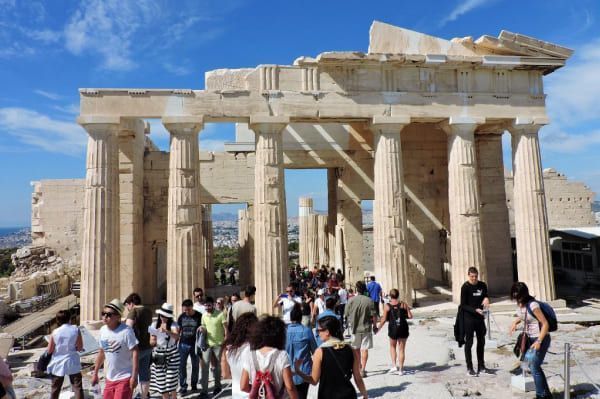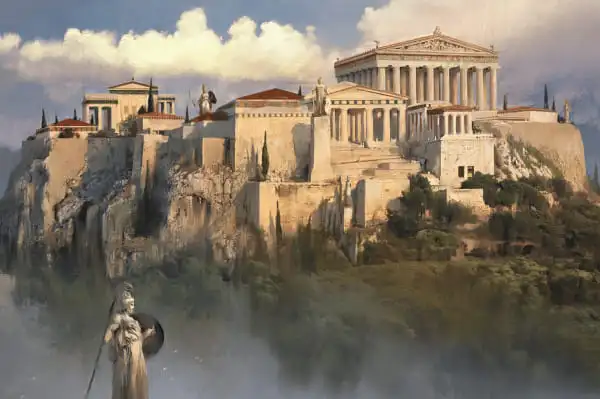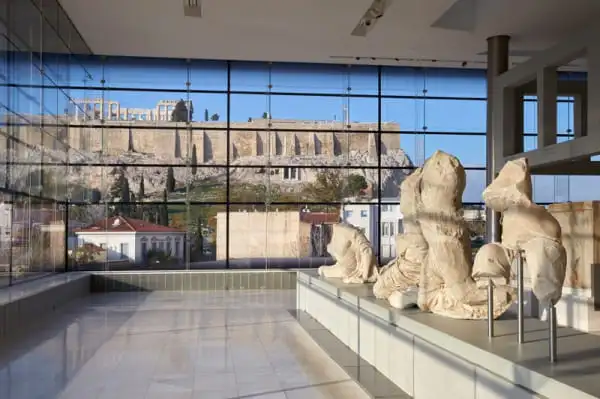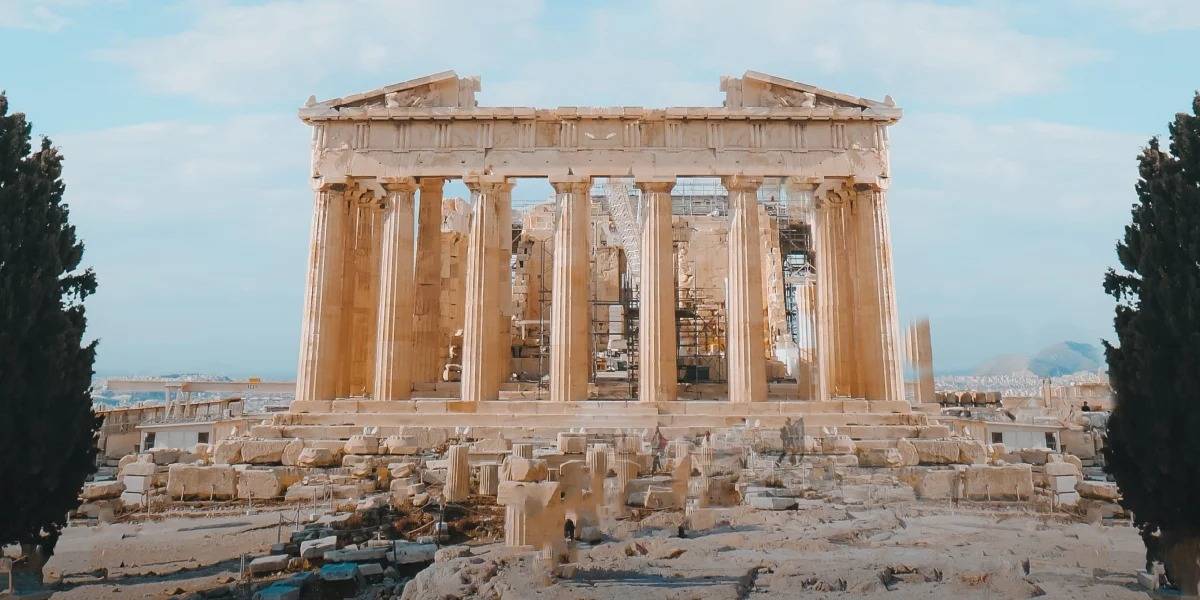
The Acropolis of Athens, a majestic rocky hill in the heart of the Greek capital, is a world-renowned archaeological site that combines elements of ancient architecture, history, and Greek mythology. This historic site, with its iconic Parthenon, is intricately linked to Greece’s rich mythological heritage and has left an indelible mark on culture and the collective imagination.
The Acropolis of Athens: A Monument to Greek Greatness
The Acropolis of Athens is a stunning testament to the architectural skill and ingenuity of ancient Greece. The top of this hill hosts a series of ancient buildings and ruins dating from the classical era, but the Parthenon is undoubtedly the jewel in the crown. This majestic temple, built in the 5th century BC, is a magnificent example of classical Greek architecture and was erected during the rule of Pericles.
The Acropolis, meaning “high city” in Greek, is the most famous of many such ancient citadels in Greece. The Acropolis of Athens is, however, unparalleled in its grandeur and historical significance. This ancient complex has witnessed the evolution of Greek culture, from the Mycenaean period to the present day.
Historical Significance
The Acropolis has played a central role in the history of Athens. It served as both the spiritual and political heart of the city. The Parthenon, one of the most iconic structures on the Acropolis, was dedicated to the goddess Athena, the city’s patron deity. It also functioned as the treasury of the Delian League, an alliance of Greek city-states led by Athens during the 5th century BCE.
Architectural Marvels
The Acropolis is a showcase of architectural brilliance. It boasts several exquisite structures, each bearing the distinct characteristics of Greek classical architecture. The Parthenon, with its Doric columns and intricate friezes, is a masterpiece of design and engineering. The Erechtheion, with its stunning Caryatid Porch, is another architectural gem.
Artistic Splendor
The Acropolis is adorned with remarkable sculptures, reliefs, and decorations. The Parthenon’s pediments and metopes, for instance, depict scenes from Greek mythology and history. The mastery of these artists lies in their ability to convey motion, emotion, and storytelling through stone.
Enduring Influence
The influence of the Acropolis on art, architecture, and culture cannot be overstated. Its architectural principles, such as the use of the Golden Ratio, continue to inspire modern designers and architects. The idea of the ideal human form, as represented in the statues on the Acropolis, has shaped the course of Western art.
Preservation and Restoration
Over the centuries, the Acropolis faced considerable damage, including destruction during the Venetian siege in the 17th century. However, extensive preservation and restoration efforts have been undertaken to protect and restore the site’s integrity. The Acropolis has also been a UNESCO World Heritage site since 1987.
A Living Legacy
The Acropolis is more than just an archaeological site; it is a living testament to the enduring legacy of ancient Greece. It serves as a beacon for those who seek to understand the foundations of democracy, art, philosophy, and Western civilization. The significance of the Acropolis goes beyond its stunning physical presence; it represents the human quest for excellence, the enduring power of culture, and the pursuit of intellectual and artistic ideals.
The Acropolis of Athens is not merely a collection of ancient structures; it is a symbol of the highest aspirations of human civilization. It encapsulates the spirit of ancient Greece and continues to inspire awe and reverence. The Acropolis stands as an enduring symbol of Greek greatness, a monument to the heights that human culture, art, and architecture can achieve. It remains a touchstone for all who seek to understand the magnificence of our shared human heritage.

Athena: The Patron Deity of Athens
Athena, the Greek goddess of wisdom, strategy, and craftsmanship, is a central figure in Greek mythology and an essential link to the Acropolis of Athens. According to legend, Athena and Poseidon, the god of the sea, competed to win the favor of the Athenians and become the city’s patron deity. In this competition, Athena offered the olive tree, a symbol of peace and wisdom, while Poseidon caused a saltwater spring to gush forth. The citizens of Athens chose Athena’s gift, securing her status as the protector of the city.
The Birth of Athena
Athena’s origin is a unique one among the Greek gods. She was born directly from the head of her father, Zeus, after he swallowed her mother, Metis, to prevent her from giving birth. This birth symbolizes Athena’s association with wisdom, as she emerged fully grown and clad in armor, ready to engage with the world.
The City of Athens
The city of Athens was named after Athena, following a legendary contest between the goddess and Poseidon, god of the sea, to determine the city’s patron deity. Athena’s gift to the city was an olive tree, a symbol of peace and prosperity, which earned her the favor of the Athenians. This story underlines the close bond between Athena and the people of Athens.
Athena Parthenos and the Parthenon
Athena’s most famous representation is the colossal statue known as Athena Parthenos. This statue, constructed from ivory and gold, stood in the Parthenon, the temple dedicated to Athena on the Acropolis of Athens. The Parthenon is not just an architectural marvel but also a testament to the city’s deep reverence for its patron goddess.
Wisdom and Culture
Athena is renowned for her wisdom, rationality, and strategic prowess. She represents the intellectual and cultural achievements of Athens, where philosophy, arts, and sciences thrived. Athena’s association with wisdom is also symbolized by her owl, which became a symbol of knowledge and enlightenment.
Protector of Heroes
Athena played a pivotal role in many Greek myths. She was the protector of heroes like Perseus and Odysseus, providing them with guidance, wisdom, and strength in their quests. Her guidance often led to heroic achievements and successful outcomes.
Athena’s Legacy
The influence of Athena extended beyond Athens. Her character represented values that transcended the city’s borders, including courage, wisdom, and justice. Her worship was widespread throughout ancient Greece, and she was often invoked for guidance and protection.
Athena’s legacy as the patron deity of Athens is a testament to the deep cultural and historical ties between the goddess and the city. Her association with wisdom, culture, and heroic endeavors reflects the essence of Athens itself. The values and virtues she embodies continue to inspire those who seek knowledge, courage, and the pursuit of intellectual and moral excellence. Athena’s legacy is not confined to ancient Greece but endures as an enduring symbol of wisdom and civilization for people worldwide.

The Relationship between Mythology and the Acropolis
The connection between Athena and the Acropolis is evident in every corner of this archaeological site. The Parthenon, the most famous temple on the Acropolis, was built in honor of Athena Parthenos, one of Athena’s epithets, meaning “Athena the Virgin.” The statue of Athena Parthenos, created by the sculptor Phidias, stood inside the temple and was considered one of the masterpieces of classical Greek art.
In addition to the Parthenon, other buildings on the Acropolis, such as the Erechtheion, are also dedicated to Greek deities and bear the imprints of mythology in their architecture and decoration.
The Birth of Athena
One of the most significant mythological narratives associated with the Acropolis is the birth of Athena, the city’s patron goddess. According to Greek mythology, Athena was born fully grown and armored from the head of her father, Zeus. She emerged from his skull after he swallowed her mother, Metis, out of fear that her child would surpass him in wisdom and power. The mythological birth of Athena, a symbol of divine wisdom, aligns perfectly with the reverence for knowledge and culture that the Acropolis represents.
The Contest of Athena and Poseidon
Another myth tied to the Acropolis involves a contest between Athena and Poseidon, the god of the sea, to determine which of them would become the patron deity of Athens. In this tale, Poseidon struck a rock with his trident, causing a saltwater spring to gush forth. Athena, on the other hand, gifted the city with an olive tree. The Athenians chose Athena’s gift, the olive tree, as it symbolized peace, prosperity, and wisdom. This myth underscores the profound connection between Athena and Athens and the values the city cherished.
The Role of Heroes
Heroes of Greek mythology also have ties to the Acropolis. Perseus, who famously slew the Gorgon Medusa, and Theseus, who defeated the Minotaur in the labyrinth, were both considered protectees of Athens. Athena played a significant role in guiding these heroes on their quests, reinforcing her position as a symbol of wisdom and strategic prowess.
Mythology in Art and Architecture
The influence of mythology on the art and architecture of the Acropolis is evident. Sculptures and reliefs, such as those on the Parthenon, depict scenes from Greek mythology and history. These artistic representations are not just artistic embellishments but are also symbolic of the virtues, values, and stories that underpinned Greek culture.
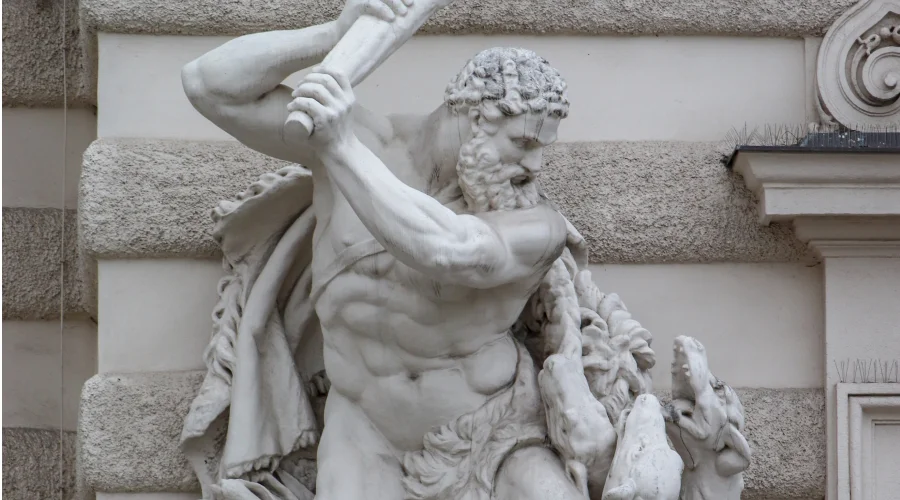
The Legacy of the Acropolis and Greek Mythology
The Acropolis of Athens is not only a testament to the architectural greatness of ancient Greece but also serves as a lasting reminder of the influence of Greek mythology on everyday life and the cultural identity of ancient Athens. Athena, the wise and protective goddess, remains a enduring symbol of the city, and her legacy, both in architecture and mythology, continues to thrive on the Acropolis and in Greek culture at large.
Mythological Roots
The Acropolis is intrinsically linked to Greek mythology through its association with the city’s patron goddess, Athena. The myth of Athena’s birth from the head of her father, Zeus, and her role as the goddess of wisdom, strategy, and warfare, is profoundly reflected in the Acropolis’s cultural and intellectual significance. The very name “Acropolis,” meaning “high city,” echoes the divine stature of the site, where Athena’s presence is inextricably interwoven with the city’s identity.
The Olive Tree and the Contest
The mythological contest between Athena and Poseidon to determine the patron deity of Athens is another tale that casts a long shadow over the Acropolis. Poseidon’s striking of the rock to create a saltwater spring and Athena’s gift of the olive tree are symbolic of the city’s choice: wisdom, peace, and prosperity over Poseidon’s offering of water. The olive tree, an enduring symbol of culture and knowledge, aligns seamlessly with the cultural heritage and values epitomized by the Acropolis.
Heroes and Guidance
Greek mythology is replete with stories of heroes guided and protected by Athena. Perseus, who slew the Gorgon Medusa, and Theseus, the hero of the Minotaur’s labyrinth, both sought and received Athena’s wisdom and protection. These tales are a testament to the goddess’s role in championing heroic virtues and the moral code that underpins Greek culture.
Myth in Art and Architecture
The art and architecture of the Acropolis are replete with mythological themes. The Parthenon, one of the most iconic structures on the Acropolis, features intricate reliefs and sculptures that depict scenes from Greek mythology. The presence of the gods, heroes, and legendary events in the art adorning the Acropolis serves as a constant reminder of the enduring connection between myth and reality.
Cultural Continuity
The Acropolis’s legacy, rooted in Greek mythology, is far from relegated to the annals of history. It remains a living testament to the cultural and intellectual achievements of ancient Greece, an enduring symbol of wisdom, knowledge, and the pursuit of excellence. The values and virtues embodied in the mythological narratives of the Acropolis continue to inspire and shape our understanding of the site’s cultural and historical significance.

Conclusion
The Acropolis’s legacy is a testament to the enduring bond between Greek mythology and the enduring cultural and intellectual achievements of Greece. The intertwining of myth and reality on the Acropolis has shaped the identity, values, and aspirations not only of the ancient Greeks but of humanity as a whole. The legacy of the Acropolis reminds us of the timeless power of myth, the enduring pursuit of wisdom, and the profound impact of Greek culture on the world’s intellectual and artistic heritage.
More information
The Acropolis ticket grants visitors access to the archaeological site of the Acropolis and its slopes, including the Parthenon, the Theater…
The Acropolis of Athens is a testament to the rich history and culture of Greece and Western civilization. Over the centuries…
The Acropolis Museum is a modern museum located in Athens, Greece, which serves as a beacon for the preservation and…

